Optimizing IOL Calculators with Deep Learning Prediction of Total Corneal Astigmatism
Abstract
1. Introduction
2. Patients and Methods
2.1. Data Acquisition
2.2. Model Development and Tested Regression Learners
2.3. Data and Statistical Analysis
3. Results
3.1. Corneal Astigmatism Components
3.2. Determining the Best Predictors and Machine Learning Architectures for TCA Prediction
3.3. Comparison of Conventional A–K Formula to Our Deep Learning Model
3.4. The Best Model: Deep Learning with J0 and J45 Astigmatism Component Split
4. Discussion
4.1. Importance of Accurate TCA Prediction
4.2. Difference between an IOL Calculator and a TCA Prediction Formula
4.3. Challenges and Limitations with Existing Solutions
4.4. Deep Learning as a Solution
4.5. Astigmatism Data Splitting versus No Splitting
4.6. Relationships between Corneal Variables
4.7. mEYEstro TCA Predictor Software
5. Limitations and Future Directions
6. Conclusions
Supplementary Materials
Author Contributions
Funding
Institutional Review Board Statement
Informed Consent Statement
Data Availability Statement
Conflicts of Interest
References
- Fabian, E.; Wehner, W. Prediction Accuracy of Total Keratometry Compared to Standard Keratometry Using Different Intraocular Lens Power Formulas. J. Refract. Surg. 2019, 35, 362–368. [Google Scholar] [CrossRef] [PubMed]
- de Jong, T.; Sheehan, M.T.; Koopmans, S.A.; Jansonius, N.M. Posterior corneal shape: Comparison of height data from 3 corneal topographers. J. Cataract. Refract. Surg. 2017, 43, 518–524. [Google Scholar] [CrossRef] [PubMed]
- Tonn, B.; Klaproth, O.K.; Kohnen, T. Anterior surface-based keratometry compared with Scheimpflug tomography-based total corneal astigmatism. Investig. Ophthalmol. Vis. Sci. 2014, 56, 291–298. [Google Scholar] [CrossRef] [PubMed]
- Wang, L.; Cao, D.; Vilar, C.; Koch, D.D. Posterior and total corneal astigmatism measured with optical coherence tomography-based biometer and dual Scheimpflug analyzer. J. Cataract. Refract. Surg. 2020, 46, 1652–1658. [Google Scholar] [CrossRef]
- Langenbucher, A.; Cayless, A.; Szentmary, N.; Weisensee, J.; Wendelstein, J.; Hoffmann, P. Prediction of total corneal power from measured anterior corneal power on the IOLMaster 700 using a feedforward shallow neural network. Acta Ophthalmol. 2022, 100, e1080–e1087. [Google Scholar] [CrossRef]
- Naeser, K.; Savini, G.; Bregnhoj, J.F. Estimating Total Corneal Astigmatism from Anterior Corneal Data. Cornea 2017, 36, 828–833. [Google Scholar] [CrossRef]
- Abulafia, A.; Koch, D.D.; Wang, L.; Hill, W.E.; Assia, E.I.; Franchina, M.; Barrett, G.D. New regression formula for toric intraocular lens calculations. J. Cataract. Refract. Surg. 2016, 42, 663–671. [Google Scholar] [CrossRef]
- Shammas, H.J.; Yu, F.; Shammas, M.C.; Jivrajka, R.; Hakimeh, C. Predicted vs measured posterior corneal astigmatism for toric intraocular lens calculations. J. Cataract. Refract. Surg. 2022, 48, 690–696. [Google Scholar] [CrossRef]
- Wang, L.; Koch, D.D. Comparison of accuracy of a toric calculator with predicted vs measured posterior corneal astigmatism. J. Cataract. Refract. Surg. 2023, 49, 29–33. [Google Scholar] [CrossRef]
- Reitblat, O.; Levy, A.; Megiddo Barnir, E.; Assia, E.I.; Kleinmann, G. Toric IOL Calculation in Eyes with High Posterior Corneal Astigmatism. J. Refract. Surg. 2020, 36, 820–825. [Google Scholar] [CrossRef]
- Kane, J.X.; Connell, B. A Comparison of the Accuracy of 6 Modern Toric Intraocular Lens Formulas. Ophthalmology 2020, 127, 1472–1486. [Google Scholar] [CrossRef] [PubMed]
- Barrett, G.D. An improved universal theoretical formula for intraocular lens power prediction. J. Cataract. Refract. Surg. 1993, 19, 713–720. [Google Scholar] [CrossRef] [PubMed]
- Darcy, K.; Gunn, D.; Tavassoli, S.; Sparrow, J.; Kane, J.X. Assessment of the accuracy of new and updated intraocular lens power calculation formulas in 10 930 eyes from the UK National Health Service. J. Cataract. Refract. Surg. 2020, 46, 2–7. [Google Scholar] [CrossRef] [PubMed]
- Koch, D.D.; Ali, S.F.; Weikert, M.P.; Shirayama, M.; Jenkins, R.; Wang, L. Contribution of posterior corneal astigmatism to total corneal astigmatism. J. Cataract. Refract. Surg. 2012, 38, 2080–2087. [Google Scholar] [CrossRef] [PubMed]
- Wallerstein, A.; Bernstein, A.; Cohen, M.; Mimouni, M.; Gauvin, M. Quantifying Age-Related Anterior and Posterior Corneal Astigmatism Relationships: Insights for IOL Calculators and Topography-Guided LASIK Protocols. OSF Preprints 2024. [Google Scholar] [CrossRef]
- Debellemaniere, G.; Dubois, M.; Gauvin, M.; Wallerstein, A.; Brenner, L.F.; Rampat, R.; Saad, A.; Gatinel, D. The PEARL-DGS Formula: The Development of an Open-source Machine Learning-based Thick IOL Calculation Formula. Am. J. Ophthalmol. 2021, 232, 58–69. [Google Scholar] [CrossRef]
- Debellemaniere, G.; Mechleb, N.; Bernier, T.; Ancel, J.M.; Gauvin, M.; Wallerstein, A.; Saad, A.; Gatinel, D. The Development of a Thick-Lens Post-Myopic Laser Vision Correction Intraocular Lens Calculation Formula. Am. J. Ophthalmol. 2024, 262, 40–47. [Google Scholar] [CrossRef]
- Gatinel, D.; Debellemaniere, G.; Saad, A.; Rampat, R.; Wallerstein, A.; Gauvin, M.; Malet, J. A Simplified Method to Minimize Systematic Bias of Single-Optimized Intraocular Lens Power Calculation Formulas. Am. J. Ophthalmol. 2023, 253, 65–73. [Google Scholar] [CrossRef]
- Gatinel, D.; Debellemaniere, G.; Saad, A.; Rampat, R.; Wallerstein, A.; Gauvin, M.; Malet, J. A New Method to Minimize the Standard Deviation and Root Mean Square of the Prediction Error of Single-Optimized IOL Power Formulas. Transl. Vis. Sci. Technol. 2024, 13, 2. [Google Scholar] [CrossRef]
- Gatinel, D.; Debellemaniere, G.; Saad, A.; Wallerstein, A.; Gauvin, M.; Rampat, R.; Malet, J. Impact of Single Constant Optimization on the Precision of IOL Power Calculation. Transl. Vis. Sci. Technol. 2023, 12, 11. [Google Scholar] [CrossRef]
- Mechleb, N.; Debellemaniere, G.; Gauvin, M.; Wallerstein, A.; Saad, A.; Gatinel, D. Using the First-Eye Back-Calculated Effective Lens Position to Improve Refractive Outcome of the Second Eye. J. Clin. Med. 2022, 12, 184. [Google Scholar] [CrossRef] [PubMed]
- Hu, Y.; Zhu, S.; Xiong, L.; Fang, X.; Liu, J.; Zhou, J.; Li, F.; Zhang, Q.; Huang, N.; Lei, X.; et al. A multicenter study of the distribution pattern of posterior corneal astigmatism in Chinese myopic patients having corneal refractive surgery. Sci. Rep. 2020, 10, 16151. [Google Scholar] [CrossRef] [PubMed]
- Nemeth, G.; Berta, A.; Lipecz, A.; Hassan, Z.; Szalai, E.; Modis, L., Jr. Evaluation of posterior astigmatism measured with Scheimpflug imaging. Cornea 2014, 33, 1214–1218. [Google Scholar] [CrossRef] [PubMed][Green Version]
- Dubbelman, M.; Weeber, H.A.; van der Heijde, R.G.; Volker-Dieben, H.J. Radius and asphericity of the posterior corneal surface determined by corrected Scheimpflug photography. Acta Ophthalmol. Scand. 2002, 80, 379–383. [Google Scholar] [CrossRef]
- Jiang, J.; Pan, X.; Zhou, M.; Wang, X.; Zhu, H.; Li, D. A comparison of IOLMaster 500 and IOLMaster 700 in the measurement of ocular biometric parameters in cataract patients. Sci. Rep. 2022, 12, 12770. [Google Scholar] [CrossRef]
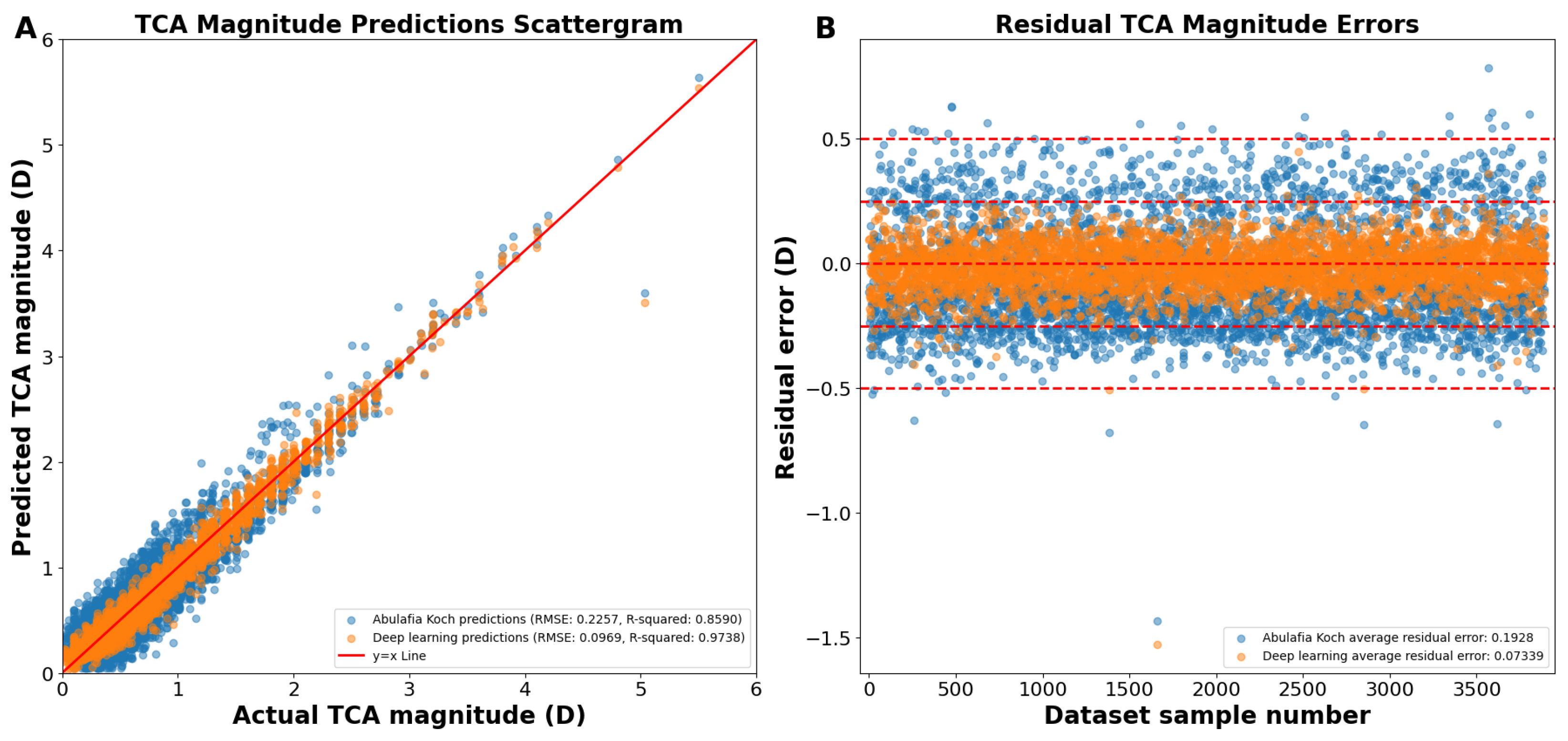
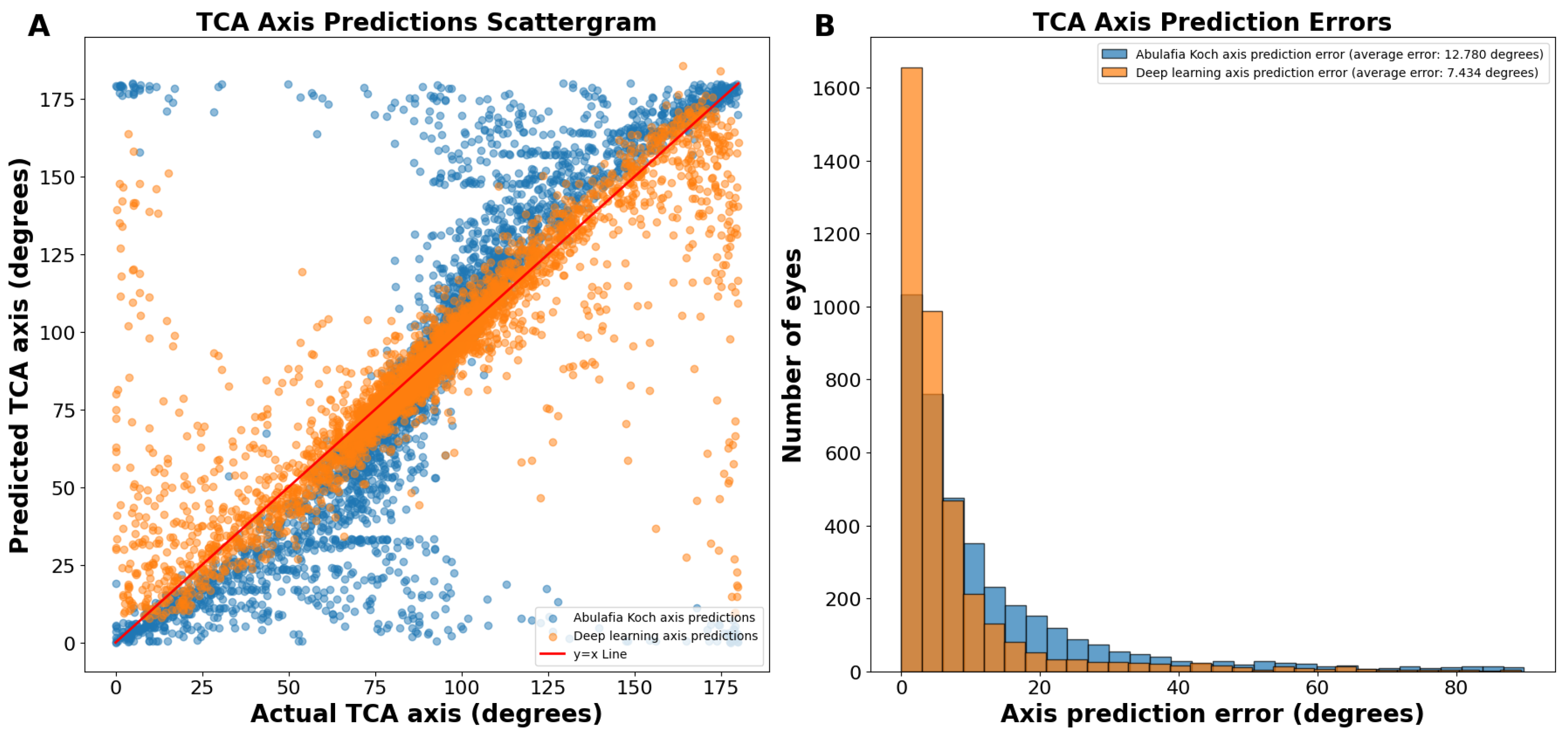
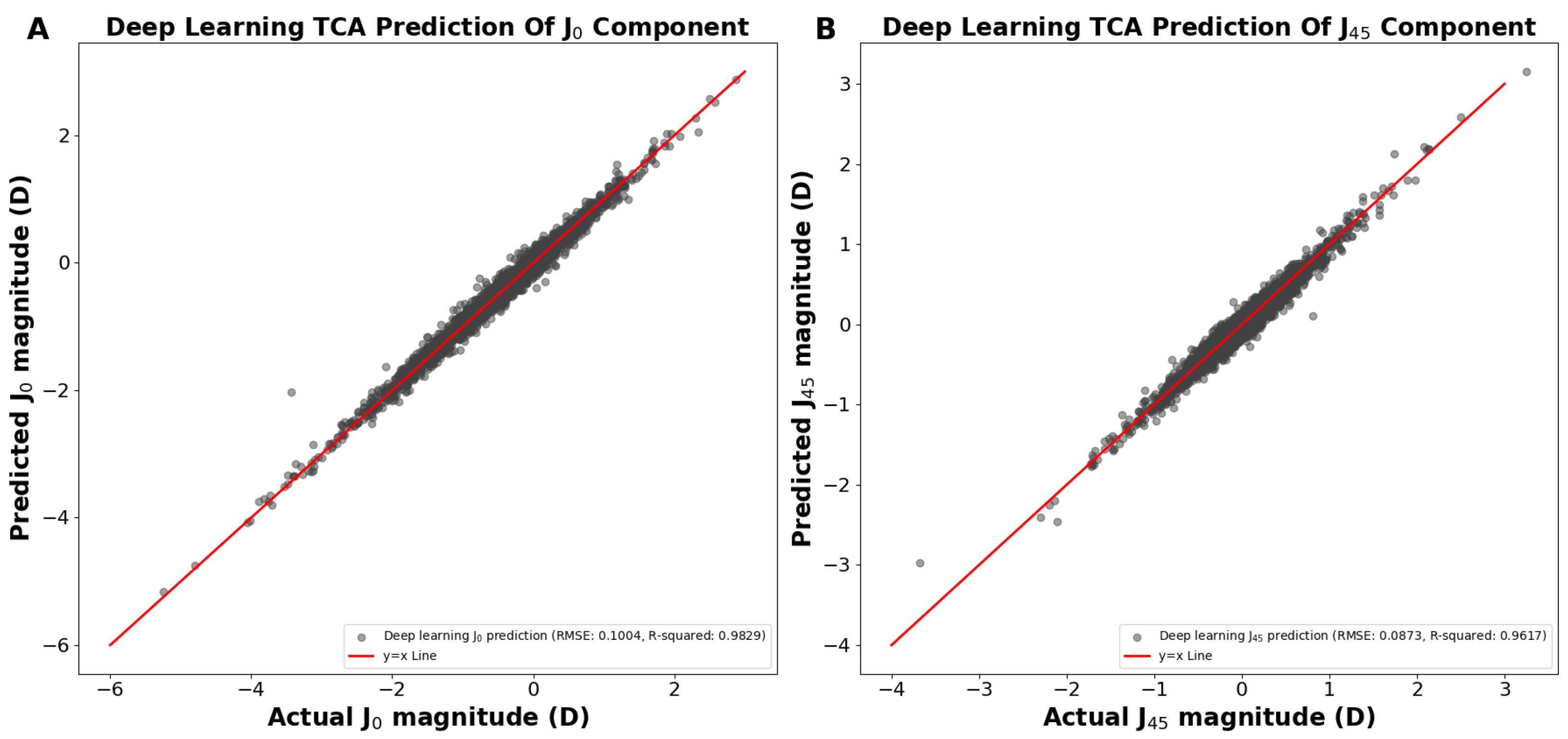
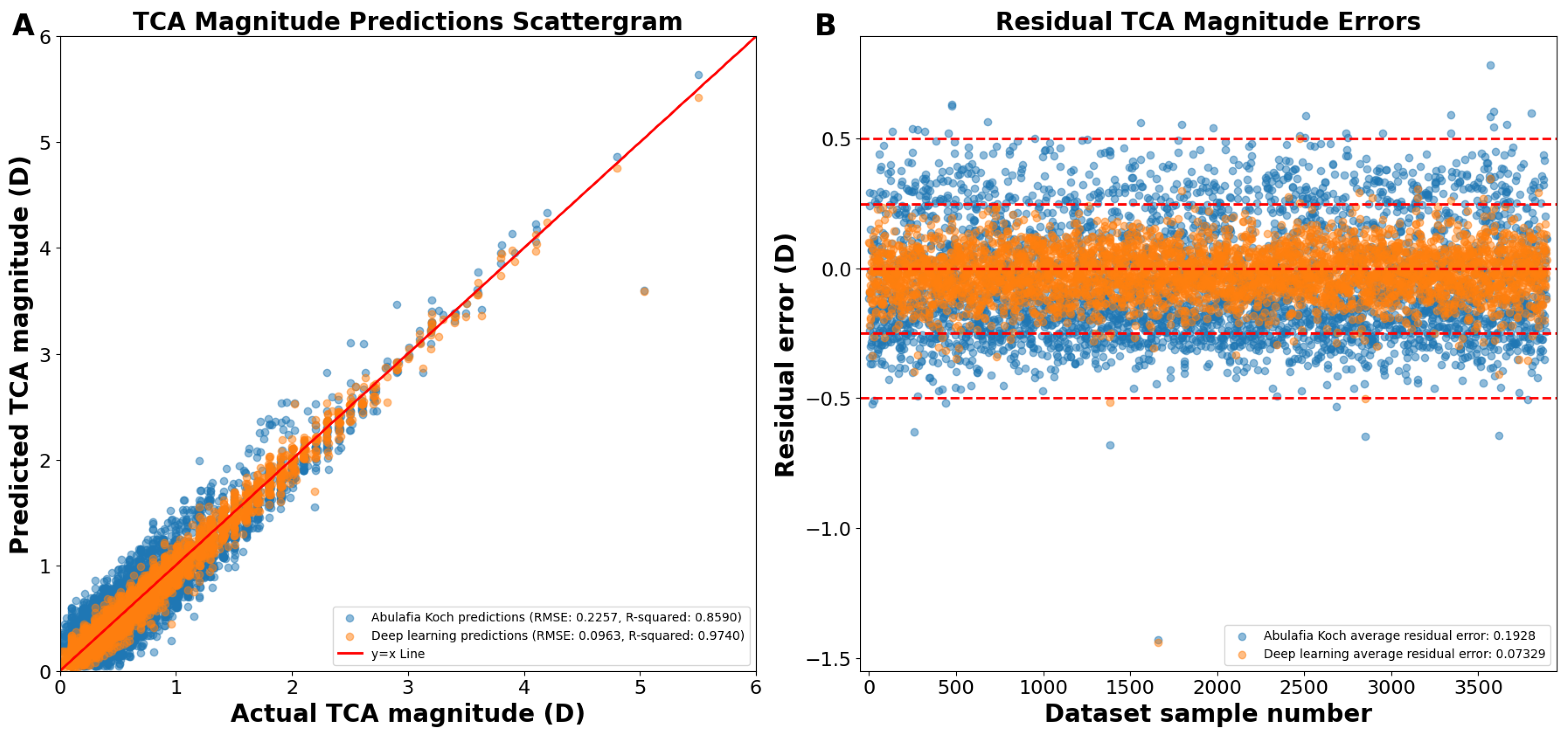
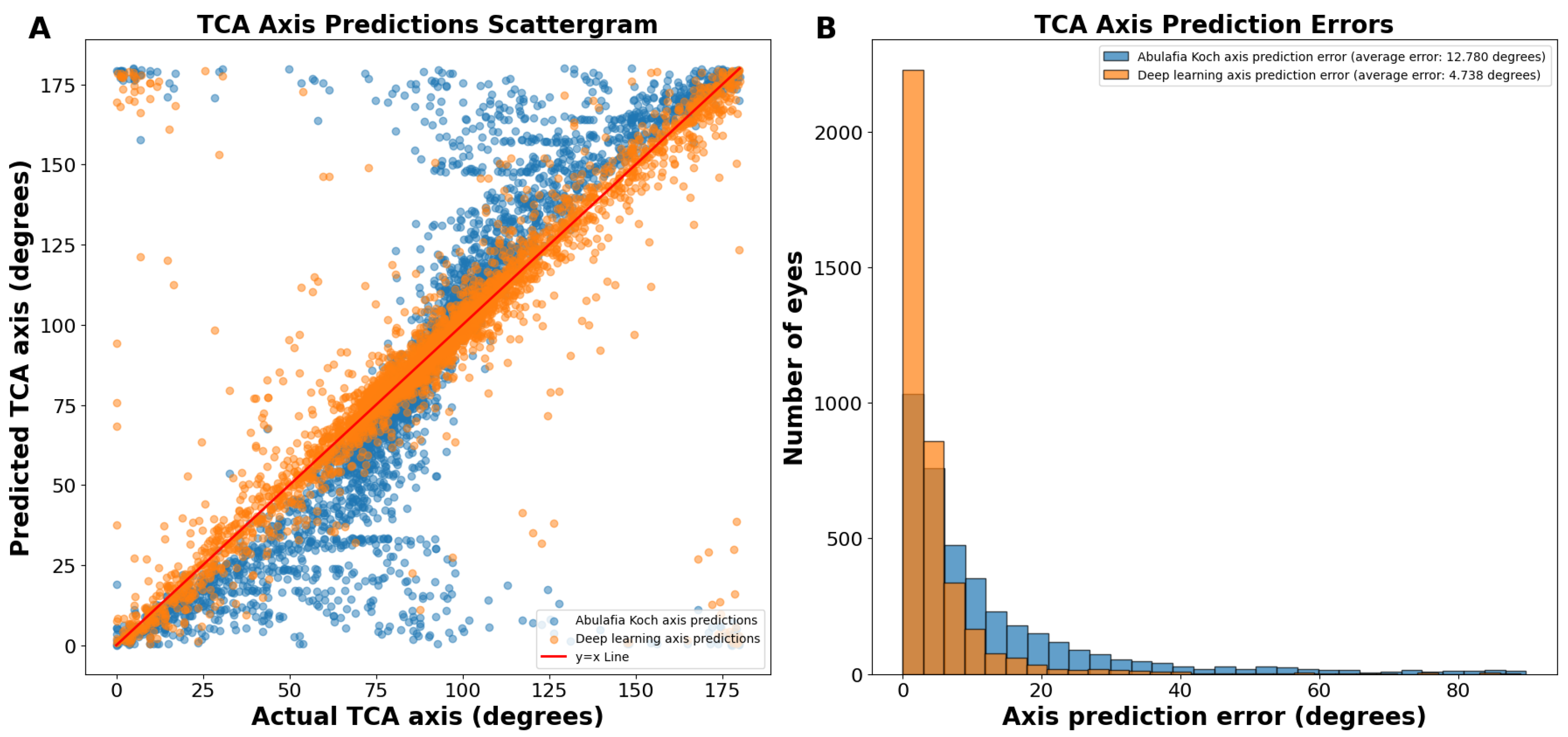
| Model Number | Model Details | R2 | Test Accuracy | Test Loss | RMSE (D) | Global Metric |
|---|---|---|---|---|---|---|
| 1 | 4fc, 3 ReLU, hd 16, 2 bn, wd | 0.9671 | 0.9687 | 0.0115 | 0.10722 | 1.81708 |
| 12 | 3fc, 2 ReLU, hd 32, 1 bn, wd | 0.9672 | 0.9680 | 0.0114 | 0.1069 | 1.81690 |
| 5 | 4fc, 3 ReLU, hd 32, 2 bn | 0.9668 | 0.9686 | 0.0116 | 0.10763 | 1.81617 |
| 3 | 4fc, 3 ReLU, hd 32, 2 bn, wd | 0.9662 | 0.9687 | 0.0118 | 0.10867 | 1.81443 |
| 16 | 2fc, 1 ReLU, hd 16, 1 bn | 0.9665 | 0.9675 | 0.0117 | 0.10811 | 1.81419 |
| 10 | 3fc, 2 ReLU, hd 32, 2 bn | 0.9659 | 0.9676 | 0.0119 | 0.10903 | 1.81257 |
| 22 | 4fc, 3 ELU, hd 32, 2 bn, wd | 0.9668 | 0.9648 | 0.0116 | 0.10761 | 1.81239 |
| 11 | 3fc, 2 ReLU, hd 16, 2 bn, wd | 0.9658 | 0.9674 | 0.0119 | 0.1092 | 1.81210 |
| 13 | 3fc, 2 ReLU, hd 32, 2 bn, wd | 0.9660 | 0.9645 | 0.0119 | 0.1090 | 1.80960 |
| 18 | 2fc, 1 ReLU, hd 32, 1 bn, wd | 0.9648 | 0.9642 | 0.0125 | 0.11185 | 1.80465 |
| 17 | 2fc, 1 ReLU, hd 16, 1 bn, wd | 0.9632 | 0.9648 | 0.0128 | 0.11334 | 1.80186 |
| 23 | 4fc, 3 Tanh, hd 16, 2 bn, wd | 0.9666 | 0.9509 | 0.0116 | 0.10789 | 1.79801 |
| 2 | 4fc, 3 ReLU, hd 16, wd | 0.9586 | 0.9586 | 0.0144 | 0.12019 | 1.78261 |
| 4 | 4fc, 3 ReLU, hd 32, wd | 0.9586 | 0.9585 | 0.0145 | 0.12026 | 1.78234 |
| 7 | 3fc, 2 ReLU, hd 32 | 0.9570 | 0.9570 | 0.0150 | 0.12246 | 1.77654 |
| 6 | 4fc, 3 ReLU, hd 32 | 0.9567 | 0.9566 | 0.0151 | 0.12298 | 1.77522 |
| 20 | 4fc, 3 Sigmoid, hd 32, 2 bn, wd | 0.9572 | 0.9531 | 0.0149 | 0.1222 | 1.77320 |
| 15 | 2fc, 1 ReLU, hd 16, wd | 0.9556 | 0.9556 | 0.0155 | 0.12441 | 1.77129 |
| 9 | 3fc, 2 ReLU, hd 32, wd | 0.9537 | 0.9537 | 0.0161 | 0.12704 | 1.76426 |
| 21 | 4fc, 3 LeakyReLU, hd 32, 2 bn, wd | 0.9660 | 0.9124 | 0.0119 | 0.10899 | 1.75751 |
| 19 | 2fc, 1 ReLU, hd 32 | 0.9518 | 0.9517 | 0.0168 | 0.12974 | 1.75696 |
| 8 | 3fc, 2 ReLU, hd 16, wd | 0.9517 | 0.9517 | 0.0169 | 0.12981 | 1.75669 |
| 14 | 2fc, 1 ReLU, hd 16 | 0.9458 | 0.9458 | 0.0189 | 0.13749 | 1.73521 |
| Magnitude Metrics | Axis Metrics | ||||
|---|---|---|---|---|---|
| Model | RMSE (D) | R2 | Average Error (D) | Average Circular Error (Degrees) | Axis Standard Deviation (Degrees) |
| Abulafia-Koch | 0.2257 | 0.8590 | 0.1928 | 12.78 | 16.03 |
| Deep Learning without J0/J45 split | 0.0969 | 0.9738 | 0.0734 | 7.43 | 11.75 |
| Deep Learning with J0/J45 split | 0.0963 | 0.9740 | 0.0733 | 4.74 | 8.07 |
Disclaimer/Publisher’s Note: The statements, opinions and data contained in all publications are solely those of the individual author(s) and contributor(s) and not of MDPI and/or the editor(s). MDPI and/or the editor(s) disclaim responsibility for any injury to people or property resulting from any ideas, methods, instructions or products referred to in the content. |
© 2024 by the authors. Licensee MDPI, Basel, Switzerland. This article is an open access article distributed under the terms and conditions of the Creative Commons Attribution (CC BY) license (https://creativecommons.org/licenses/by/4.0/).
Share and Cite
Wallerstein, A.; Fink, J.; Shah, C.; Gatinel, D.; Debellemanière, G.; Cohen, M.; Gauvin, M. Optimizing IOL Calculators with Deep Learning Prediction of Total Corneal Astigmatism. J. Clin. Med. 2024, 13, 5617. https://doi.org/10.3390/jcm13185617
Wallerstein A, Fink J, Shah C, Gatinel D, Debellemanière G, Cohen M, Gauvin M. Optimizing IOL Calculators with Deep Learning Prediction of Total Corneal Astigmatism. Journal of Clinical Medicine. 2024; 13(18):5617. https://doi.org/10.3390/jcm13185617
Chicago/Turabian StyleWallerstein, Avi, Jason Fink, Chirag Shah, Damien Gatinel, Guillaume Debellemanière, Mark Cohen, and Mathieu Gauvin. 2024. "Optimizing IOL Calculators with Deep Learning Prediction of Total Corneal Astigmatism" Journal of Clinical Medicine 13, no. 18: 5617. https://doi.org/10.3390/jcm13185617
APA StyleWallerstein, A., Fink, J., Shah, C., Gatinel, D., Debellemanière, G., Cohen, M., & Gauvin, M. (2024). Optimizing IOL Calculators with Deep Learning Prediction of Total Corneal Astigmatism. Journal of Clinical Medicine, 13(18), 5617. https://doi.org/10.3390/jcm13185617






